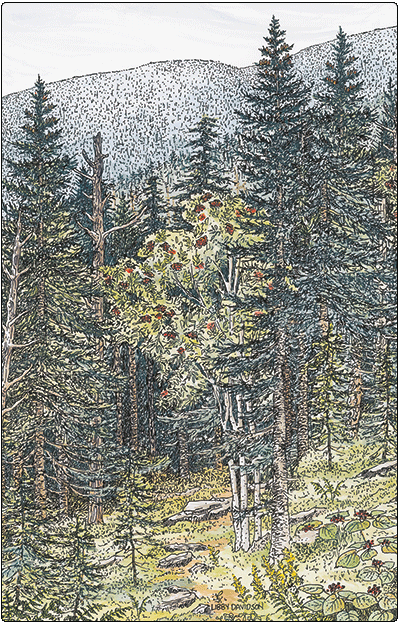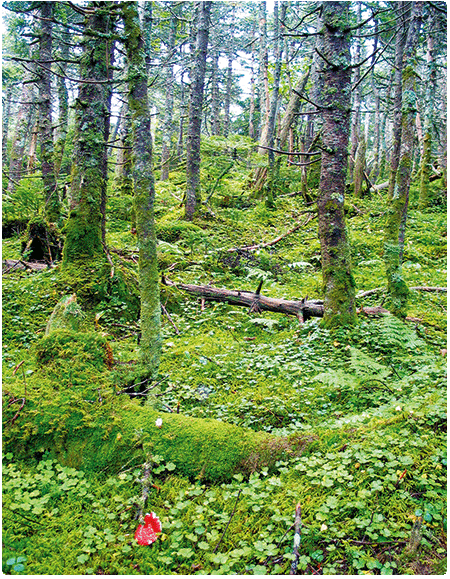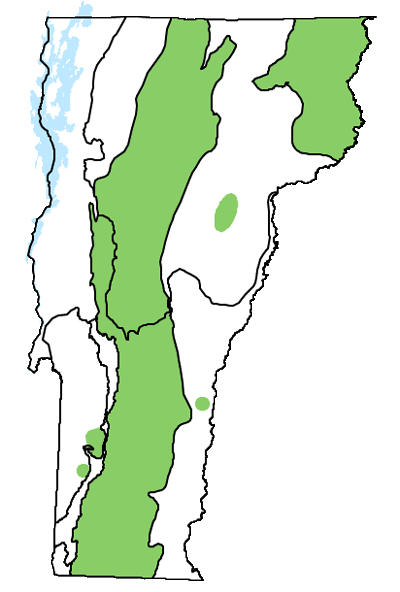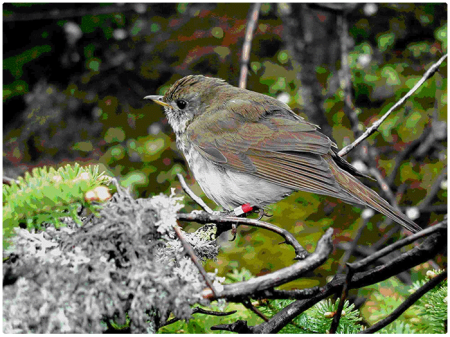Ecology and Physical Setting 
Along the spine of the Green Mountains, on mountains like Monadnock in Vermont’s Northeastern Highlands, and on a few peaks in the Taconic Mountains, Montane Spruce-Fir Forest is dominant. In these places, we consider this forest the matrix-forming community. Montane Spruce-Fir Forests occur mostly above 2,800 feet elevation in the Southern Green Mountains and Taconic Mountains. In the Northern Green Mountains and Northeastern Highlands, the lower limit ranges from 2,500 feet to 2,700 feet. Below this elevation, Montane Yellow Birch-Red Spruce Forest is the dominant community.
The climate on these mountains is cold and severe. Summers are short and foggy; winters are cold and windy. Clouds are frequent and count as one of the main ecological influences on vegetation. Mountaintop clouds form when moist air rises and condenses as it cools. Often, on a still day, the only clouds in sight are those that cap the mountaintops. One of the effects of all this excess moisture is a constant supply of water to the forests. Foliage intercepts water droplets, which then fall to the ground as fog drip. This fog drip can be a significant and important source of moisture for plants. Continually wet, spongy conditions on upper mountain trails testify to the quantity of water captured in this way. The down side of all the fog, however, is that it limits light infiltration and therefore cuts down on photosynthetic activity, even when the temperatures are quite warm. Considering the influence of clouds on Montane Spruce-Fir Forests, it may well be, as has been proposed by one scientist, that the lower elevational limit of this community on New England mountains corresponds to the prevailing lower limit of clouds.
Soils in Montane Spruce-Fir Forests are spodosols—acidic, leached soils that are low in fertility. A typical soil profile shows dramatic color differences between layers, evidence of the leaching. The soil profile illustrated on page 16 is a spodosol. The soils are vulnerable to disturbance from downslope movement and windthrow, which are common on Montane Spruce-Fir Forests. Downslope movement can be dramatic when soils become super-saturated. In very steep places like Smugglers Notch, landslides are commonplace. Other processes that affect these forests are ice and snow, which can damage plant tissues and also break tree limbs, and natural fires. Some of the fires that occurred in these forests in the last 200 years were caused, either directly or indirectly, by humans.
Montane Spruce-Fir Forests dot the upper elevations of the Appalachians as far south as the North Carolina-Tennessee border. Moving southward, however, one has to look higher and higher to find the dark green of the spruce and fir. In the Great Smokies, for example, it doesn’t begin until about 5,000 feet elevation.
Vegetation
In this cloudy, cold environment, mosses thrive and are sometimes the dominant vegetation on the forest floor. Dense carpets of sphagnum moss, which are usually associated with bogs, are common throughout the forest on moist sites, for example on cliffs where dripping groundwater and fog provide a constant supply of moisture. Schreber’s moss is abundant on drier sites. Lichens do well in these forests, too, hanging from trees and clinging to bark, taking moisture from the air. Herbs are sparse in the dark understory, but those that do thrive are mountain wood fern, brownish sedge, bluebead lily, whorled aster, common wood sorrel, and shining clubmoss. American mountain ash and striped maple (moosewood) are scattered shrubs. Hobblebush, a low shrub that makes a tangle with its reclining branches, can be abundant.
Above the forest floor the canopy is dense with red spruce and balsam fir, though in places it is broken by hardwood species like heart-leaved paper birch or American mountain ash. Birch can be abundant where the soil has been disturbed by downslope movement or by fire and can persist for long periods of time where the disturbance recurs with frequency.
Balsam fir is the more common softwood species at higher elevations. At the very highest elevations of Montane Spruce-Fir Forest, just below Subalpine Krummholz, black spruce begins to mix in with balsam fir, and red spruce is sparse.
Wildlife Habitat
Montane Spruce-Fir Forests blanket Vermont’s highest mountains and form some of the largest continuous patches of coniferous forests. In a state dominated by hardwoods, these mountain-top forests are exceptionally important—they are effectively sky-islands of boreal habitat. Bicknell’s thrush is one of the rarest inhabitants, and breeds exclusively in the fir and birch forests of the northern Appalachian Mountains. Other breeding birds include white-winged crossbill, yellow-rumped warbler, Blackburnian warbler, red-breasted nuthatch, and both ruby-crowned and golden-crowned kinglets. The blackpoll warbler migrates to South America, more than 5,600 miles from its Vermont mountain breeding grounds. Not surprisingly, it is one of the last warblers to return in spring.
Red squirrels are abundant in spruce-fir forests, since red spruce and balsam fir seeds are among their preferred foods. Red squirrels nest in tree cavities of mature forests or build globular nests in treetops. They line their nests with soft materials including moss, grass, and leaves. Several species of voles and shrews make use of the mossy, rocky, and log-strewn forest floor. The rare southern bog lemming is known from Montane Spruce-Fir Forests, as well as some lowland forests. Snowshoe hare may be abundant, especially in areas with dense brushy understories that provide browse and cover from predators. Moose frequently move to higher elevation forests during the winter in search of browse.
Successional Trends
Where Montane Spruce-Fir Forests are disturbed and where mineral soil is laid bare, either through natural processes like landslides or through human disturbances such as logging and accidental burning, paper birch or heart-leaved paper birch most commonly replace the softwoods. Pin cherry and mountain maple are prevalent in these situations as well. These hardwood species, especially paper birch, can persist for a long time following a disturbance, but where soils are stable, spruce and fir ultimately dominate.
The natural death and replacement of fir trees can create striking vegetation patterns at the highest elevations in these forests. Where they are dramatically displayed, these patterns are very regular and are known as “fir waves.”
Variants
- Montane Fir Forest occurs at upper elevations, where balsam fir dominates and the height of the trees is generally lower.
- Montane Spruce Forest occurs at lower elevations, where balsam fir is nearly absent, trees are taller, and hardwoods are more commonly mixed in.
Related Communities
- Lowland Spruce-Fir Forest tends to be less stressed by wind and ice. It occurs in basins and other landscape settings where cold air settles. The herbs and shrubs that characterize high elevation forests (mountain wood fern, for example) are absent, and white spruce may be present in the canopy.
- Montane Yellow Birch-Red Spruce Forest is found at lower elevations, generally 2,000 to 3,000 feet. This community has deeper soils, less severe climate, and more hardwood species in the canopy.
- Subalpine Krummholz is found above Montane Spruce-Fir Forest. This community has low, stunted trees. Red spruce is nearly absent, and black spruce is common.
- Red Spruce-Heath Rocky Ridge is found on dry ridgelines and slopes, primarily below 3,000 feet. Although these two communities share many species, Red Spruce-Heath Rocky Ridges lack the deeper soils and lush moss cover associated with Montane Spruce-Fir Forest.
Conservation Status and Management Considerations
Many of Vermont’s Montane Spruce-Fir Forests have been logged, have had roads and ski trails built through them, or have been otherwise disturbed by humans. During the late 19th century and early 20th century, heavy logging took place in high-elevation forests, with spruce in especially high demand. In very steep areas, trees were moved downslope using natural slides and cliff faces. This period of heavy logging and major soil disturbance was followed by a period of frequent fires, some caused by lightning and some directly by humans. Many of today’s high-elevation paper birch forests originated at this time. In spite of modern intrusions, these forests are probably in better shape overall than they were 100 years ago.
There are large areas of this community that are virtually undisturbed because of inaccessibility; also, many mountains have isolated pockets of undisturbed Montane Spruce-Fir Forest.
Climate change will alter the species composition of these montane forests and may reduce their area.
Any activities in Montane Spruce-Fir Forest should be conducted with great care because of steep slopes and fragile soils. Logging is generally not recommended above 2,500 feet.
Distribution/Abundance
Montane Spruce-Fir Forest is common in Vermont at elevations above 2,500 feet (or higher in the southern part of the state). This community can be found throughout the mountains of northern New England and into Canada and in the mountains as far south as Tennessee.
Characteristic Plants
Trees
Abundant Species
Red spruce – Picea rubens
Balsam fir – Abies balsamea
Occasional to Locally Abundant Species
Yellow birch – Betula alleghaniensis
Heart-leaved paper birch – Betula cordifolia
Black spruce – Picea mariana
Shrubs
Occasional to Locally Abundant Species
Mountain maple – Acer spicatum
Striped maple – Acer pensylvanicum
Hobblebush – Viburnum lantanoides
Showy mountain ash – Sorbus decora
American mountain ash – Sorbus americana
Bartram’s shadbush – Amelanchier bartramiana
Herbs
Occasional to Locally Abundant Species
Whorled aster – Oclemena acuminata
Common wood sorrel – Oxalis montana
Bluebead lily – Clintonia borealis
Bunchberry – Cornus canadensis
Shining clubmoss – Huperzia lucidula
Mountain wood fern – Dryopteris campyloptera
Ground cedar – Diphasiastrum digitatum
Bryophytes and Lichens
Abundant Species
Schreber’s moss – Pleurozium schreberi
Stair-step moss – Hylocomnium splendens
Knight’s plume moss – Ptilium cristra-castrensis
Common fern moss – Thuidium delicatulum
Occasional to Locally Abundant Species
Pincushion moss – Leucobryum glaucum
Windswept moss – Dicranum spp.
Moss – Sphagnum russowii
Three-lobed bazzania – Bazzania trilobata
Bristly beard lichen – Usnea hirta
Monk’s hood lichen – Hypogymnia physodes
Common antler lichen – Pseudevernia consocians
Rare and Uncommon Plants
Lesser pyrola – Pyrola minor
Showy mountain ash – Sorbus decora
Northern sweet cicely – Osmorhiza depauperata
Mountain sweet cicely – Osmorhiza berteroi
Squashberry – Viburnum edule
Small-flowered woodrush – Luzula parviflora
Tea-leaved willow – Salix planifolia
Associated Animals

Montane Spruce-Fir Forest and Subalpine Krummholz.
Smoky shrew – Sorex fumeus
Southern red-backed vole – Myodes gapperi
Red squirrel – Tamiasciurus hudsonicus
Snowshoe hare – Lepus americanus
Northern flying squirrel – Glaucomys sabrinus
Moose – Alces americanus
Blackpoll warbler – Setophaga striata
Yellow-rumped warbler – Setophaga coronata
Blackburnian warbler – Setophaga fusca
Red-breasted nuthatch – Sitta canadensis
Dark-eyed junco – Junco hyemalis
White-throated sparrow – Zonotrichia albicollis
Winter wren – Troglodytes hiemalis
Ruby-crowned kinglet – Regulus calendula
Golden-crowned kinglet – Regulus satrapa
Ruffed grouse – Bonasa umbellus
Common raven – Corvus corax
Rare and Uncommon Animals
American marten – Martes americana
Long-tailed shrew – Sorex dispar
Southern bog lemming – Synaptomys cooperi
Rock vole – Microtus chrotorrhinus
Bicknell’s thrush – Catharus bicknelli
White-winged crossbill – Loxia leucoptera
Subarctic darner – Aeshna subarctica
Places to Visit
Camel’s Hump, Duxbury and Huntington, Camel’s Hump State Park, Vermont Department of Forests, Parks, and Recreation (VDFPR)
Glastenbury Mountain, Glastenbury, Green Mountain National Forest
Mount Mansfield, Cambridge and Underhill, Mount Mansfield State Forest, VDFPR
Mount Ascutney, Windsor, West Windsor, and Weathersfield, Mount Ascutney State Park, VDFPR
